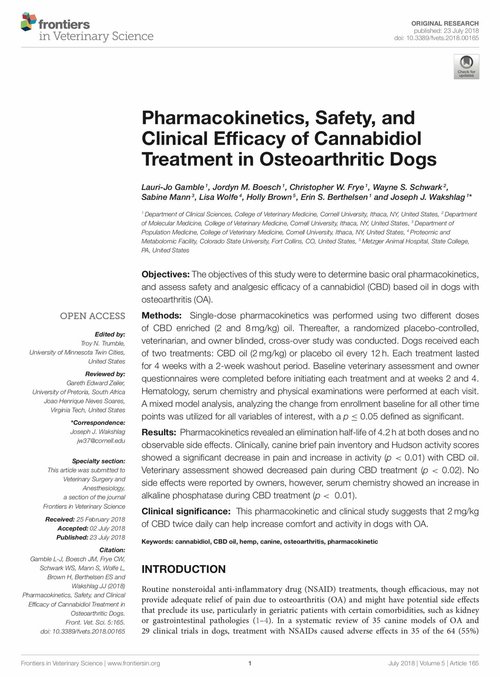Cannabidiol dexmedetomidine chronic pain killer
DOULEUR CHEZ LES CHIENS ET CHATS
1 Pharmacokinetics, Safety, and Clinical Efficacy of Cannabidiol Treatment in Osteoarthritic Dogs
Tayari, H., Bell, A.
Veterinary Record Case Reports, 2019, 7: e000727.
Résumé :
Pharmacokinetics revealed an elimination half-life of 4.2 h at both doses and no observable side effects. Clinically, canine brief pain inventory and Hudson activity scores showed a significant decrease in pain and increase in activity (p < 0.01) with CBD oil. Veterinary assessment showed decreased pain during CBD treatment (p < 0.02). No side effects were reported by owners, however, serum chemistry showed an increase in alkaline phosphatase during CBD treatment (p < 0.01).
This pharmacokinetic and clinical study suggests that 2 mg/kg of CBD twice daily can help increase comfort and activity in dogs with OA.

2 Dexmedetomidine infusion as perioperative adjuvant in a dog undergoing craniotomy
Tayari, H., Bell, A.
Veterinary Record Case Reports, 2019, 7: e000727.
Résumé :
A 10-year-old castrated boxer with behavioural change due to a cerebellar meningioma was presented for intracranial surgery. As intracranial structures are virtually incompressible, any volume-occupying lesions such as meningiomas might raise intracranial pressure compromising cerebral perfusion. To avoid severe neuronal damage, maintaining and optimising the delicate balance between intracranial pressure and perfusion is mandatory. Dexmedetomidine, an α2-adrenoreceptor agonist, is gaining consensus in human neuroanaesthesia as an adjuvant in patients undergoing craniotomy. Unlike short-acting opioids, dexmedetomidine does not cause respiratory depression while having analgesic and neuroprotective properties; it provides a significant reduction of perioperative volatile anaesthetic and opioid requirements ensuring haemodynamic stability and smooth recoveries. Due to this dog’s aggressive behaviour and a shortage of remifentanil, dexmedetomidine infusion was chosen as part of the perioperative management of this patient.
3 Qualitative study of owner perceptions of chronic pain in their dogs
Kelly N. Davis bs Peter W. Hellyer dvm, ms Eloise C. J. Carr rn, phd Jean E. Wallace phd Lori R. Kogan phd
Journal of the American Veterinary Medical Association January 1, 2019, Vol. 254, No. 1, Pages 88-92
Résumé :
To understand the experiences of owners of dogs with chronic pain and explore owner perceptions of their pets’ pain. Owners were interviewed by means of a semistructured and conversational technique. Interviews were then transcribed and analyzed with standard qualitative methodology to code for major themes.
Major themes that were identified included changes in owner schedule, effects on owner relationships, and necessary resources when owning a pet with chronic pain. Owners discussed their perceptions of their pets’ pain, and several participants referred to empathizing with their pet owing to their own experiences with pain. Owners also suggested ways that veterinarians can support them during the experience of owning a dog with chronic pain.
By understanding the impact of chronic pain on dog owners and appreciating how owners perceive pain in their pets, veterinarians may be able to provide better care for patients and clients.
4/ A new painkiller nanomedicine to bypass the blood-brain barrier and the use of morphine
Jiao Feng, Sinda Lepetre-Mouelhi, Anne Gautier, Simona Mura, Catherine Cailleau, François Coudore, Michel Hamon and Patrick Couvreur
Science Advances, 13 Feb 2019, Vol. 5, no. 2, eaau5148
Résumé :
The clinical use of endogenous neuropeptides has historically been limited due to pharmacokinetic issues, including plasma stability and blood-brain barrier permeability. In this study, we show that the rapidly metabolized Leu-enkephalin (LENK) neuropeptide may become pharmacologically efficient owing to a simple conjugation with the lipid squalene (SQ). The corresponding LENK-SQ bioconjugates were synthesized using different chemical linkers in order to modulate the LENK release after their formulation into nanoparticles. This new SQ-based nanoformulation prevented rapid plasma degradation of LENK and conferred on the released neuropeptide a notable antihyperalgesic effect that lasted longer than after treatment with morphine in a rat model of inflammation (Hargreaves test). The biodistribution study as well as the use of brain-permeant and -impermeant opioid receptor antagonists indicated that LENK-SQ NPs act through peripherally located opioid receptors. This study represents a novel nanomedicine approach, allowing the specific delivery of LENK neuropeptide into inflamed tissues for pain control.
PDF à http://advances.sciencemag.org/content/5/2/eaau5148/tab-pdf




